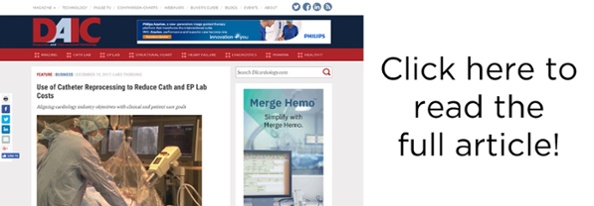American healthcare is highly profitable if you are a device maker - but challenging if you are a patient or a hospital administrator
It’s a story that takes place in our industry all too frequently. A technician from a large electrophysiology (EP) device manufacturer enters an EP Lab, as they do every day, to support EP cases with specific knowledge about the devices their company has sold to the lab. Upon noting that an intracardiac echocardiography catheter originally manufactured by his employer has been reprocessed (saving the hospital about $1,250 and delivering exactly the same functionality), this individual immediately leaves the EP Lab with the patient on the procedure table. Why? The technician has been instructed to do so by his employer. Meanwhile, nowhere in the agreement with the EP device manufacturer has it been stipulated that the provision of ongoing interventional support was necessary for the use of devices. This may not sound like a credible story, yet it happens in EP Labs across the country.
For the hospital, reprocessing is essentially a matter of controlling the medical device investment by optimizing device utilization: If a device can be used twice, costs go down by the price of one new device. Of course, the medical device manufacturer loses revenue when a hospital reprocesses their devices. So clearly, after the regulation of reprocessing turned out to legitimize rather than kill the practice, medical device manufacturers have explored other ways to maintain and grow their device revenue. Unfortunately, these strategies are also dramatically reducing hospital savings from reprocessing. Several different techniques are being used including:
- Questioning the safety of reprocessed devices in spite of FDA’s stamp of approval, and in spite of the fact that reprocessed devices have more rigorous controls and need to be inspected individually
- Tying capital equipment acquisition to the use of consumables (devices)
- Shortening product lifecycles, leveraging the lag in the reprocessor R&D process to secure periods of un-reprocessability
- Threatening to remove case support when reprocessed devices are used
- Designing (built-in) obsolescence through device chipping, software, or simple device design
Manufacturers, who are highly profitable, are profiting even more from the same growth in EP and cardiology demand that is making hospitals lose money and reduce their ability to care for patients.
The manufacturing industry should not be able to take away the decision-making ability of hospitals looking to reprocess medical devices. Part of the challenge for hospitals is a significant market imperfection: not only are hospitals taken hostage by device makers in areas like capital equipment contracts, but there are so few suppliers in the market that the threat of switching supplier sometimes is just not viable. However, not all EP device manufacturers take this approach, and hospitals would benefit from aligning more closely with suppliers who demonstrate a focus on overall hospital value.
Read more in this recent article in Diagnostic & Interventional Cardiology.




